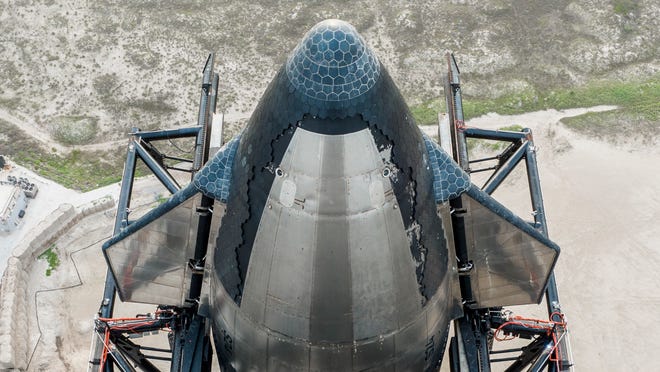Space is important to us and that’s why we’re working to bring you top coverage of the industry and Florida launches. Journalism like this takes time and resources. Please support it with a subscription here.
—
BREVARD COUNTY, Fla. — Shortly after SpaceX’s massive Starship launched from Texas on its first full test early Thursday, the 400-foot stack of hardware began to tumble until it broke apart in a fiery explosion over the Gulf of Mexico.
The overall demonstration mission – a test of the new rocket’s ability to ignite and clear the pad’s 500-foot tower – was successful. At liftoff, however, several of the rocket’s 33 Raptor engines failed to fire up as planned. Then came the more than minute-long tumble at roughly three minutes into flight, which kicked off just after the rocket’s Starship upper stage and Super Heavy booster failed to separate.
Some experts and spectators were left wondering if the test flight’s explosive conclusion was the result of aerodynamic forces shearing the vehicle apart or if it was purposefully blown up by the flight termination system, or FTS. SpaceX did later confirm the rocket’s breakup was triggered by FTS.
Flight termination systems are essentially explosives built into key areas of rockets and are, at least on newer vehicles, automatically triggered if a hardware failure is detected. They’re a safety and licensing requirement and are especially important if a rocket appears to veer off course.
STARSHIP LAUNCH:Explosion ends SpaceX Starship launch, but mission still successful
STARSHIP BACKGROUND:In Texas, SpaceX is ready to bet the house on Starship’s first orbital launch
But Thursday’s launch from Starbase, a SpaceX-operated facility near Brownsville, Texas, was unique. Not only was it a test flight of a brand new vehicle, meaning slightly different parameters for termination, but it also flew from an area entirely new to launching orbital missions — previous Starship test flights ended explosively, but did not attempt to reach high altitudes.
A launch of the same magnitude from Florida might have had stricter parameters meaning the rocket wouldn’t have been allowed to tumble as long, for example.
“Every range has what’s called impact limit lines,” Mike Leinbach, NASA’s former space shuttle launch director, told FLORIDA TODAY, part of the USA TODAY Network. “That’s the theoretical limit that the vehicle can fly within. They’re boundaries projected on a map that if the vehicle goes out of those boundaries, the flight termination system kicks in.”
Why Flight Termination Systems are used
In Florida, the Eastern Range — Cape Canaveral Space Force Station and Kennedy Space Center — is overseen by the Space Force’s Space Launch Delta 45, which is also partially responsible for certifying termination systems. At SpaceX’s facility in Texas, there is no Space Force presence there, so the Federal Aviation Administration plays a larger role.
Abhi Tripathi, director of mission operations at the University of California, Berkeley, Space Sciences Laboratory, said there are many reasons why a rocket’s termination system is triggered: loss of thrust, unplanned acceleration, failures with certain components, off-course trajectories, and more.
“I’m venturing to guess it already didn’t have enough thrust even before FTS kicked in because, like everyone else, I could see several engines were out. So at that point, some software trigger also said, ‘Sorry, don’t have enough juice to get to space anymore’ and FTS kicked in,” Tripathi said.
Starship’s auto-destruct triggers likely would have been different for the Texas-based liftoff in comparison to more commonly seen Falcon 9 launches from Florida. Tripathi said if Starship had launched from Kennedy Space Center instead, the triggers likely would have been modified to fit an already existing system like Falcon 9.
“I would assume the triggers would be entirely consistent with Falcon 9’s (SpaceX’s workhorse rocket) triggers … in terms of the narrowness of the corridor and other related things,” Tripathi said.
Sometimes termination is intentional
Past incidents involving FTS are few and far between, but it’s a potential factor during every launch.
One of the more recent, high-profile incidents involving FTS was actually intentional: in January 2020, SpaceX purposefully simulated the loss of a Falcon 9 rocket to test an uncrewed Crew Dragon capsule’s escape system performance. The mock emergency saw the capsule successfully detect an anomaly, then rapidly propel away from the exploding rocket below — a move that would have saved astronaut lives had they been on board.
Another factor when it comes to Florida launches is population and development. During NASA’s first launch of the Space Launch System rocket from pad 39B in November 2022, the rocket’s flight termination system was a big topic of discussion: what if it had to be triggered shortly after liftoff, sending debris raining down over the Atlantic Ocean?
Fortunately, that did not come to pass as the Artemis I mission was successful, but SLS was also a big rocket. The bigger the vehicle, the bigger the potential for damages should things go wrong.
At Kennedy Space Center, SpaceX is still targeting no earlier than the evening of Wednesday, April 26, for its next launch: a three-core Falcon Heavy. The 230-foot rocket will fly from pad 39A with a communications satellite around 7:30 p.m. EDT, but the mission won’t include the usual side booster landings at Cape Canaveral.
The rocket’s center core also won’t be recovered after liftoff due to the weight and destination of the satellite.


